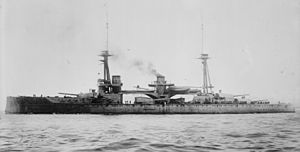HMS Neptune (1909)

Neptune before 1915
|
|
| Class overview | |
|---|---|
| Operators: |
|
| Preceded by: | St Vincent class |
| Succeeded by: | Colossus class |
| Built: | 1909–1911 |
| In commission: | 1911–1921 |
| Completed: | 1 |
| Scrapped: | 1 |
| History | |
|
|
|
| Name: | Neptune |
| Namesake: | Neptune |
| Ordered: | 14 December 1908 |
| Builder: | HM Dockyard, Portsmouth |
| Laid down: | 19 January 1909 |
| Launched: | 30 September 1909 |
| Completed: | January 1911 |
| Commissioned: | 11 January 1911 |
| Out of service: | November 1921 |
| Fate: | Sold for scrap, September 1922 |
| General characteristics (as built) | |
| Type: | Dreadnought battleship |
| Displacement: | 19,680 long tons (20,000 t) (normal) |
| Length: | 546 ft (166.4 m) (o/a) |
| Beam: | 85 ft (25.9 m) |
| Draught: | 28 ft 6 in (8.7 m) |
| Installed power: |
|
| Propulsion: | 4 × shafts; 2 × steam turbine sets |
| Speed: | 21 knots (39 km/h; 24 mph) |
| Range: | 6,330 nmi (11,720 km; 7,280 mi) at 10 knots (19 km/h; 12 mph) |
| Complement: | 756–813 (1914) |
| Armament: |
|
| Armour: | |
HMS Neptune was a dreadnought battleship built for the Royal Navy in the first decade of the 20th century, the sole ship of her class. Shortly after her completion in 1911, she carried out trials of an experimental fire-control director and then became the flagship of the Home Fleet. Neptune became a private ship in early 1914 and was assigned to the 1st Battle Squadron (BS).
The ship became part of the Grand Fleet when it was formed shortly after the beginning of the First World War in August 1914. Aside from participating in the Battle of Jutland in May 1916 several months later, and the inconclusive Action of 19 August, her service during the war generally consisted of routine patrols and training in the North Sea. Neptune was deemed obsolete after the war and was reduced to reserve before she was sold for scrap in 1922 and subsequently broken up.
The only battleship of the 1908–1909 Naval Programme, Neptune was an improved version of the preceding St Vincent class with additional armour and the armament rearranged for greater efficiency. She was the first British dreadnought that differed in her gun turret layout from Dreadnought. Unlike the earlier ships, her wing turrets were staggered "en echelon" so that all five turrets could shoot on the broadside, although in practice the blast damage to the superstructure and boats made this impractical except in an emergency. Neptune was also the first British dreadnought to be equipped with superfiring turrets, in an effort to shorten the ship and reduce costs. A further saving in length was achieved by siting the ship's boats on girders over the two wing turrets to reduce the length of the vessel. However, if the girders were damaged during combat, they could fall onto the turrets, immobilising them. The bridge was also situated above the conning tower, which similarly risked being obscured if the bridge collapsed.
...
Wikipedia
